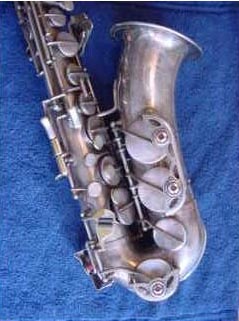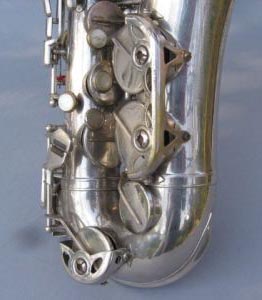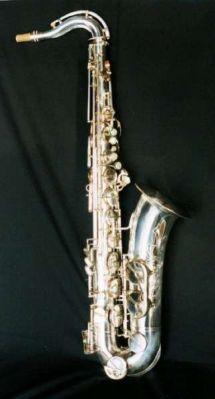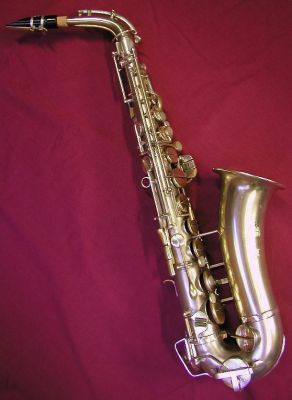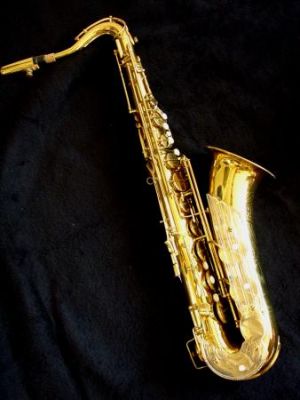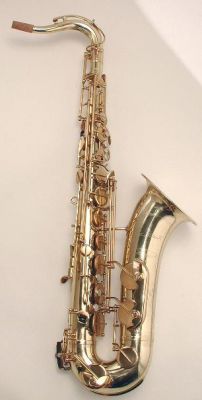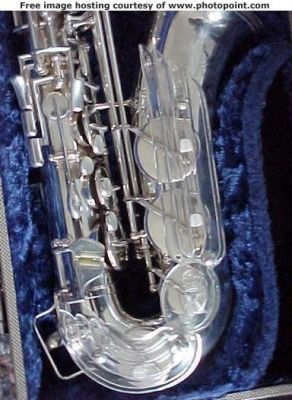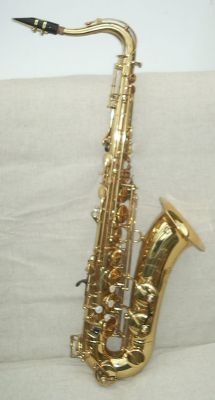* Series 0: Wire-keyguard design. Unknown serial number range, but fairly early.
* Series I: from about 10xxx to 20xxx:
In my opinion, the nicest model. An elaborately engraved horn with
funky offset side chromatic Bb/C and altissimo E vent keys, a microtuner
neck and rolled tone holes.
Oddly, the
Toneking model lacks the offset side keys and additional pearl keytouches of the New King model. I don't have enough data to determine if the bore is any different. Maybe, but, considering that these horns were made in such low quantities, it's more probable that it's not.
* Series II: beveled tone holes and
left-hand bell keys were used on about 500 to 1000
horns after Keilwerth moved from Czechoslovakia to
Germany. These horns are such a radical departure from the Series
I, they could be considered a completely different model. I believe
this is intentional, as Amati co-opted the Toneking name and design
(see below). There may also not have been any Tonekings of this series.
This model may have been developed in conjunction with Kohlert, as some rumors suggest.
The other interesting thing about these horns is that
they're one of the four I'm aware of that had beveled tone holes.
The others are early
Couesnons, Martin and some early Bueschers.
There are also
at least two generations of these horns: bell keys on the
left or bell keys on the right. They otherwise look
identical.
* Series III: from about 21xxx to 45xxx:
The introduction of the horns with the stunning lucite keyguard --
but the elimination of the microtuner neck. Rolled tone holes seem
to be added randomly to these models.
I've been asked about the horns that have METAL keyguards in the same shape as the lucite ones: are they original? My answer: possibly.
I can imagine, because the lucite keyguards are so brittle, that after a year or two, Keilwerth offered the metal guard as an option -- or they used them as warranty replacements. However, I've been unable to find a serial number range for "just metal" or "just lucite", so the idea that the metal keyguards are replacements, either from the factory or other 3rd party company, is probably the most accurate.
* Series IIIa: In 1956, an interesting horn shows up: the
V. Kohlert & Sons model
with a label on the back, that reads, "JGK: The Best in the World" and "Made in Czechoslovakia". It's an odd horn because it doesn't look like any other New King model. The reason for this is because I don't really believe it's a Keilwerth, but an Amati horn. Take a look at the below article regarding the Amati Toneking and my notes on the
Kohlert page.
* Series IV: from about 45xxx to 905xx.
These are a somewhat cheaper looking horn, with sheet-metal keyguards.
This is the series that the extremely famous
H-Couf,
Conn DJH Modified, King Tempo, Armstrong Heritage,
Bundy/Bundy Special (and a few others) are stenciled from.
I can confirm that the Keilwerth-made Bundys are great
horns, but remember that they were marketed as
student horns and may
be made from lower quality materials and may lack in some features (see,
for instance, this
link, which compares a Series I to an Esquire model tenor).
This instrument is one of only
two made and is in excellent original condition. Here's the
story!! This sax came out of the Keilworth [sic] factory a few
years ago. The factory had two graduating apprentices, and for
their final project were given the task of making a Low A bass
each. The sax has no markings at all and no sn# as it is a
handmade prototype, (You can tell its handmade as can see where
they have moved a few posts etc (trial/error) for the keywork.)
A major dealer in Europe bought them both from the factory, sold
one to Switzerland and here's the other!!!!



